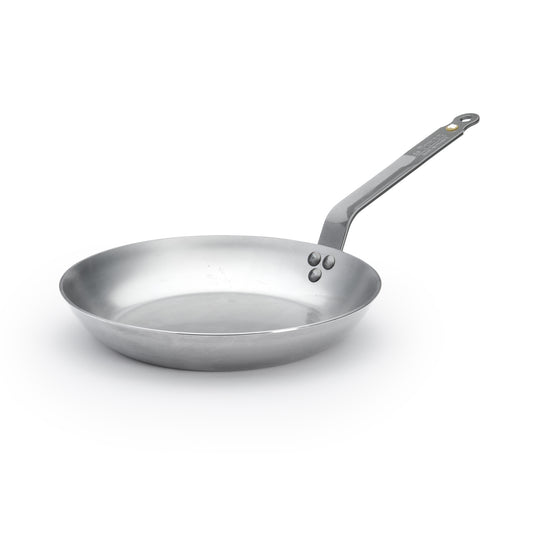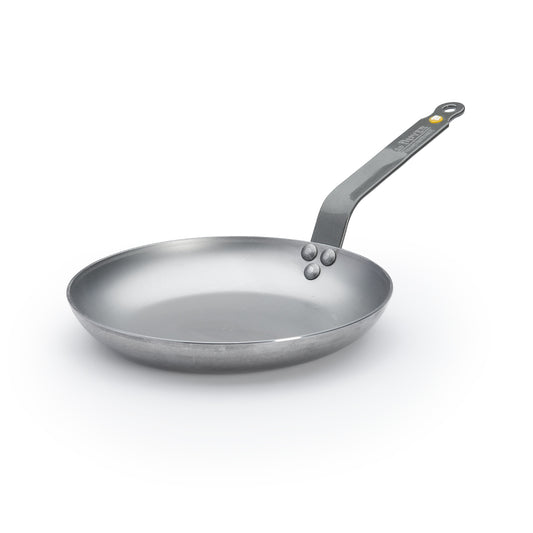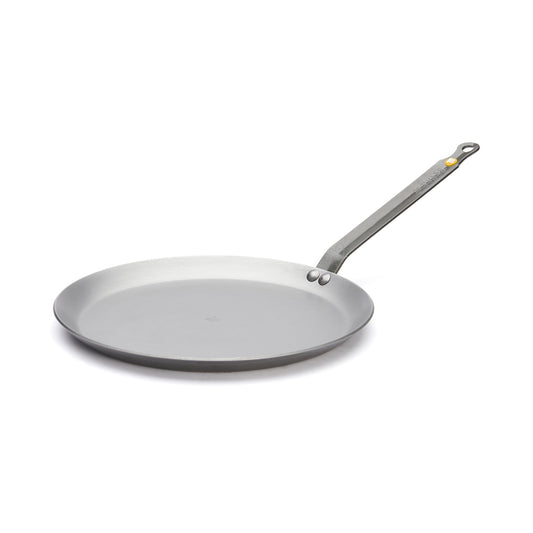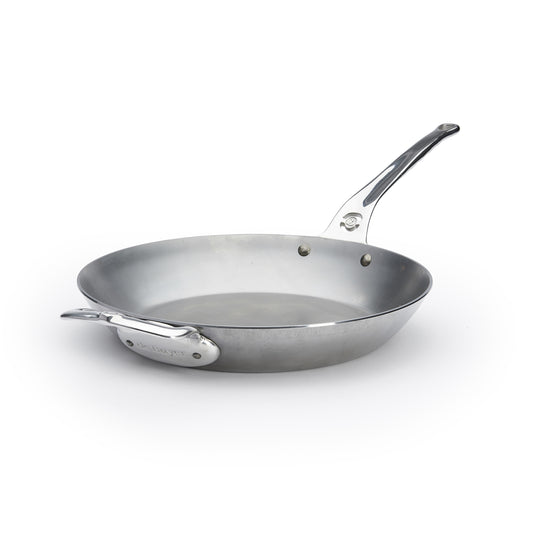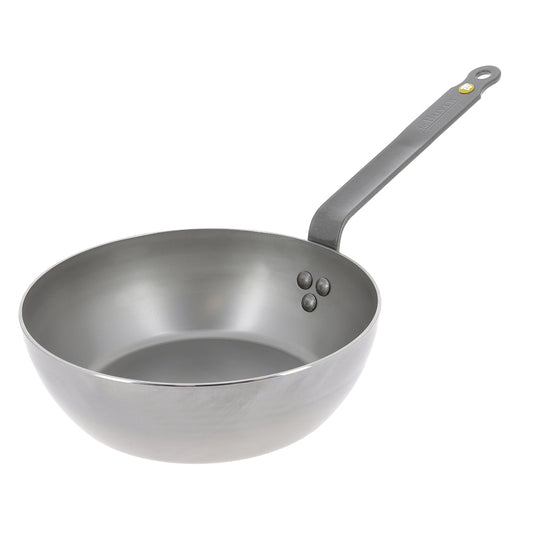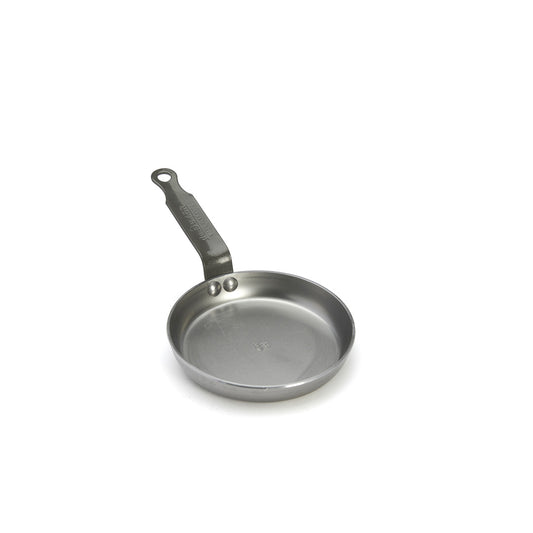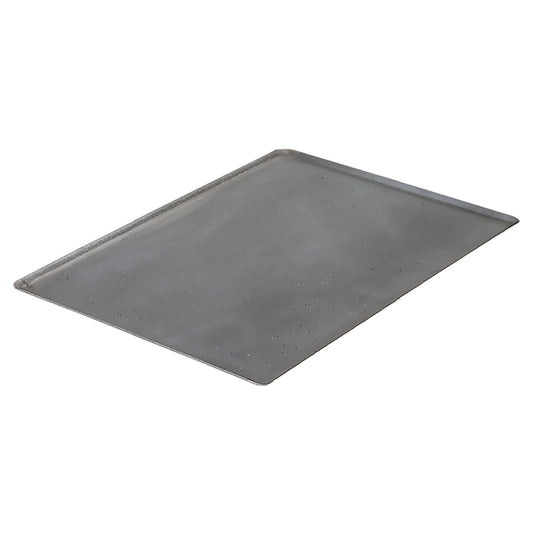From Pan to Plate: How to Cook With Stainless Steel
Master how to cook with stainless steel using essential tips on heat control, searing, cleaning, and more. Unlock chef-level results in your kitchen.
de Buyer

There’s a good reason stainless steel cookware is a chef favorite. It’s durable and versatile, among other benefits, without the higher price point of copper. The trade-off is that cooking with stainless steel for the first time is often frustrating.
If used improperly, food will stick and burn, creating an inedible mess. This article will guide you in mastering stainless steel cooking without all the trial and error. At de Buyer, we’re dedicated to education and committed to quality. Learn to use premier de Buyer cookware how it’s meant to be.
Stainless Steel Basics: What You Need to Know
Before you start cooking, here are the basics you should be aware of.
Material Composition
Any stainless steel pan on the market today is made of a steel alloy, usually containing iron, chromium, and nickel, layered with aluminum for conductivity. You’ll often hear of 5-ply and 3-ply stainless steel cookware variants. The main difference is that 5-ply consists of five layers of metal: three inner layers of aluminum sandwiched between two layers of stainless steel. Meanwhile, 3-ply consists of only one inner layer of aluminum.
Both variations are durable and extremely conductive. Think of the 5-ply as the elevated pan for professional chefs and serious home cooks. 5-ply pans are slightly more conductive and responsive to heat changes; however, 3-ply remains an excellent option.
Heat Conductivity and Retention
The aluminum core reacts quickly to heat while the surrounding steel maintains the heat. Together, the metals get hot fast and maintain consistent temperatures across the pan’s surface. With stainless steel, you can trust that your pan will stay hot.
Why Stainless Steel is a Popular Choice
The inherent durability makes stainless steel an economical choice, especially for busy kitchens. The non-reactivity means it can be used to cook a variety of foods. The aesthetic appeal means it looks gorgeous hanging on your pot rack or simmering gravy on your stove.
How to Cook With Stainless Steel
With stainless steel, you can create the perfect bite. From crispy vegetables to tender fish, these pots and pans are powerhouse cooking options that deliver it all. Use the following guide to learn how to cook with stainless steel the right way.
Preheating Properly
Use the water test to check for proper preheating. Flick a few drops of water on the pan. If the water beads and rolls around, then your pan is preheated. If the water sizzles and evaporates, it’s not ready for cooking. This droplet reaction is called the Leidenfrost effect. It occurs when a liquid touches a surface much hotter than its boiling point, and a vapor layer forms, insulating the liquid and causing it to bead up and glide, creating a nonstick effect.
This nonstick effect in the water also happens when you cook on a preheated surface. Instead of sticking eggs to the pan, they cook on top of the surface and slide off when done.
Temperature Control
Precise and consistent heat is the key to perfectly cooking eggs, steak, asparagus, and more. Stainless steel naturally excels at this temperature control. Bring out the best in your cookware by incrementally adjusting the heat for different cooking tasks. Avoid blasting your pan with medium heat when all you need is low heat.
Set the right temperature for your needs, and the pan will comply shortly. There’s no need to overcorrect.
Deglazing
The deglazing process loosens and dissolves the flavorful browned bits, called fond, that stick to the bottom of a pan after cooking. This is the first step in creating a rich sauce base. Add a liquid like stock or wine to a hot pan and gently scrape at the fond.
Even if you aren’t planning on making a sauce or gravy, the deglazing process makes cleanup easier. Pour some water, instead of a rich stock or wine, into your pan and remove the stubborn fond before taking your pan off the heat.
Searing and Browning
At its simplest, you achieve a perfect sear by leaving food alone and at the right temperature. This browning is achieved through a chemical reaction called the Maillard reaction. It’s a cornerstone of good cooking that browns food while enhancing its flavor and texture.
First, sugars and proteins react to form glycosylamines. These rearrange into aminoketones, which then transform into flavorful, aromatic, and colorful compounds. Though complex, this reaction creates rich, browned food, achieved quickly by sautéing with minimal fat.
Preventing Sticking and Damage
Just like a cast iron pan, nonstick pan, and copper pan, stainless steel cookware also requires special care to maintain. Here are some of the steps you can take to prevent sticking, damage, and warping.
- Don’t cook with a cold pan.
- Don’t overcrowd the pan.
- Don’t use excessive heat.
- Always preheat your oil in the pan.
- Avoid extreme temperature changes.
- Always allow food to sear before attempting to move it.
- Store your pan properly.
An effective cleaning routine remedies cooking mistakes and keeps your pan in top shape without scratching it in the process. When you first unbox your stainless steel pan, wash it with dish soap and water to remove packaging residue. This gentle method also clears water spots from the dishwasher.
You can use this cleaning method going forward, but for tough stains, use baking soda and water. Simply scrub gently at the stain with a paste of baking soda and water. Avoid harsh abrasives like a wire brush since they may scratch the pan.
Turning Up the Flavor: Perfect Cooking Results
The best way to ensure a perfect end cooking result is through practice. Over time you'll master the basics like proteins, veggies, and sauces. Follow these brief guides to cook steak and vegetables, and don't forget to practice and refine your technique.
You must let the steak sit out for 20 to 30 minutes before cooking. Use this time to preheat your pan and add oil. When searing, give it around 2 to 4 minutes per side without moving it, and add butter, garlic, and herbs at the last minute; baste for flavor. Use a thermometer throughout this process to get the right doneness.
- Medium Rare Steak: 130–135°F
- Medium Steak: 135–145°F
- Medium Well Steak: 145–155°F
- Well Done Steak: 155°F and up
For most vegetables and sauces, movement and agitation are key. For example, when sautéing green beans, use a wooden spoon to keep them in motion. They will sauté evenly on all sides with this method.
Tips For Even and Flavorful Cooking
- Use the correct pan size: Pan size matters most when baking, but it still plays a role when cooking. A pan that is too large for your dish wastes oil and is a misuse of space. Too small, and you can't evenly distribute foods.
- Distribute food evenly: Crowding food in a pan results in uneven, undercooked, and burnt food.
- Allow the material to shine: You don’t need to add a bunch of cooking oil to a stainless steel pan unless you're frying something. The nonstick properties of stainless steel combined with its non-reactive nature enhance the natural flavors of food.
- Using appropriate herbs and spices: Less is more when it comes to flavorings. Follow your chosen recipe, and if you’re winging it, start out with ½ teaspoon of spice or less.
Discover the World of Stainless Steel Cooking
Master key techniques like using the right-sized pan, letting your pan preheat, and cleaning properly to cook with stainless steel like a pro. Practice and experiment with stainless steel cooking on your own. It only takes a little practice to master your favorite recipes.
Arm yourself with high-performance cookware at de Buyer. Our commitment to quality is evident in every pan; you can taste it in every dish. Explore the stainless steel options for a professional-grade pan made to last.
Learn More
Recommended for You
-
MINERAL B PRO Carbon Steel Fry Pan
Regular price $90.00Regular priceUnit price / per$0.00Sale price $90.00 -
MINERAL B Classic Carbon Steel Fry Pan
Regular price $60.00Regular priceUnit price / per -
MINERAL B Carbon Steel Omelette Pan
Regular price $65.00Regular priceUnit price / per -
MINERAL B PRO Carbon Steel Omelette Pan
Regular price $105.00Regular priceUnit price / per -
Protective Sleeve for Pan Handle
Regular price $9.95Regular priceUnit price / per -
MINERAL B Carbon Steel Crepe & Tortilla Pan
Regular price $70.00Regular priceUnit price / per -
MINERAL B PRO Carbon Steel Fry Pan with Helper Handle
Regular price $145.00Regular priceUnit price / per -
Blue Carbon Steel Fry Pan
Regular price $45.00Regular priceUnit price / per -
Blue Carbon Steel Crepe & Tortilla Pan
Regular price $25.00Regular priceUnit price / per -
MINERAL B Carbon Steel Country Fry Pan
Regular price $100.00Regular priceUnit price / per -
MINERAL B Carbon Steel Egg & Pancake Pan
Regular price $35.00Regular priceUnit price / per -
Blue Carbon Steel Rectangular Baking Sheet
Regular price $35.00Regular priceUnit price / per












